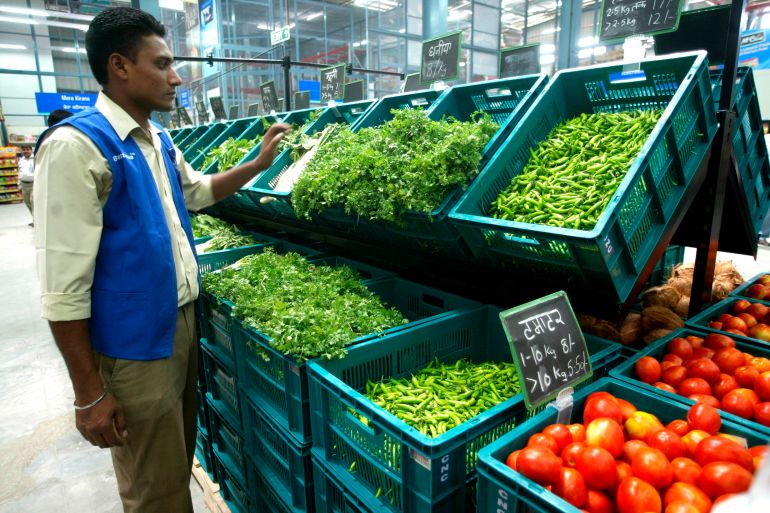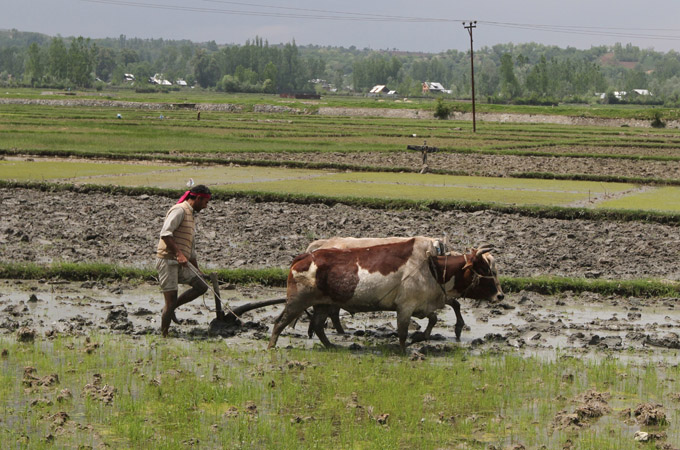No therapy in retail
The entry of big corporations into the food chain pushes up retail costs and decreases the share of the farmer.

 |
| As a commodity, food is divorced from its sources – the seeds, the soil, the farmer [EPA] |
New Delhi, India – In November 2011, when the UPA government announced that it had cleared the entry of big retail chains such as Walmart and Tesco into India through 51 per cent Foreign Direct Investment (FDI) in multi-brand retail, it justified the decision saying that FDI in retail would boost food security and benefit farmers’ livelihoods.
But the assurance that FDI in retail would ease inflation did not resolve the political crisis the government was facing; it deepened it. Parliament was stalled for several days of the Winter Session, after which the government was forced to withdraw its decision.
Keep reading
list of 4 itemsKey takeaways from Xi Jinping’s Europe trip
When will EVs become mainstream in the US?
Key takeaways from Xi Jinping’s European tour to France, Serbia and Hungary
The story of FDI in retail goes back to 2005, when Prime Minister Manmohan Singh signed an agriculture agreement with the US, along with the nuclear agreement. On the board of the US-India Knowledge Initiative in Agriculture, as it is called, sit Monsanto (the world’s leading producer of GM seeds), ConAgra (among the world’s biggest agribusinesses, along with Cargill) and Walmart (the world’s largest retail giant).
Protests had prevented Walmart’s entry into retail, but, in 2007, it did get a backdoor entry through a joint-venture with Bharti (their stores go by the names of Easyday and Best Price Modern Wholesale). No back-end infrastructure has been built so far, one of the other claims of the government about why we need retail giants.
|
Farmers’ suicides spike in India |
The way the UPA government tried to ram through the decision on FDI in retail – without consulting the opposition parties, or even its allies – was clearly undemocratic. But the decision itself was also flawed. It illustrated a disconnect between an ideology based on market fundamentalism – which is the leaning of the present government – and the Indian reality of small farms and small retail.
Industrialisation means hunger
There is also a disconnect between that ideology with its code word of “reform”, and the crisis that market fundamentalism is facing – worldwide, as well as in India. If anything needs reform, it is the failed paradigm of corporate globalisation.
Firstly, rising prices are driven by the commodification of food and speculation on food commodities. Industrialisation and globalisation of food and agriculture has transformed food from a source of life into a commodity, and as a commodity, food is divorced from its sources – the seeds, the soil, the farmer – and from its end use as nourishment for our bodies.
Industrialisation of agriculture and the commodification of food is justified on grounds of producing more food and reducing hunger. However, industrial agriculture wastes and destroys resources – the soil, the water, the biodiversity – produce food. The book American Wasteland by Jonathan Bloom reveals that the US wastes 50 per cent of the $925bn of food it grows each year.
Industrialisation of food also degrades and denitrifies food. We, therefore, have a dual malnutrition crisis – the crisis faced by one billion people who do not get access to food, and another two billion who have access to industrial food, but not to healthy food, and so suffer from food-related diseases such as obesity, diabetes and hypertension.
Industrialisation thus creates hunger. And by increasing the costs of production, it creates a negative economy, locking farmers and food producers into debt. In the “Third World”, debt translates into hunger. Hunger is also created by the commodification of food. The industrial model of food production is producing commodities, not food. More commodities do not mean less hunger, but more. And when food becomes a commodity, it becomes an object of speculation for profits, robbing the poor of their entitlements.
Big corporations, big retail costs
As a commodity, it does not matter what food is used for. Food can be transformed into feed for animals in factory farms, or into fuel to run cars. Seventy per cent of the food grain in the US is used to feed animals, 30 per cent to feed cars. The proposed increase through FDI will take this to 40 per cent, creating a conflict between feed and fuel, and pitting both against food. This diversion of food to feed and fuel competes with the food needs of the poor. It creates food scarcity and contributes to the rise in food prices.
When food is treated as a commodity, it does not matter how it is produced – whether GM seeds were used or not, whether it is produced chemically or organically. But how food is produced does determine what happens to our soil, biodiversity and water; it also determines whether farmers live or die. And how food is produced determines whether what we eat nourishes our bodies or contributes to disease and ill-health.
|
“The entry of big corporations into the food chain polarises prices, decreasing the share of the farmer and increasing the retail costs.“ |
When food is a commodity, it becomes the object of speculation. Putting food on the global casino table takes food away from people’s kitchens and plates.
Secondly, the entry of big corporations into the food chain polarises prices, decreasing the share of the farmer and increasing the retail costs. This polarisation of prices is structural; corporations make their profits through vertical integration and controlling the entire food chain.
They buy cheap from farmers and sell at high cost when they have a monopoly. The control of big retail over the food system has brought down the farmers’ share to as little as two per cent. Before liberalisation, the difference between wholesale prices and retail prices was a mere six per cent.
No need for a middle man
After the removal of quantitative restrictions, which opened up India to dumping of subsidised products, wholesale prices started to go down while retail prices continued to climb. The entry of retail giants will further push wholesale prices down, without taming the price rises. It is not the number of middlemen that matters, but the size of a middleman. A giant retailer is a giant middleman.
It might be a single player, but it harvests super profits at the cost of society. That is how the Walton family, which owns Walmart, owns $100bn of personal wealth – equivalent to the combined wealth of the bottom 30 per cent of US society. You do not accumulate that kind of money by paying farmers higher prices and bringing consumers cheaper products. Walmart and Tesco are not friends of farmers, as is being projected by the government and corporate spokesmen.
The Financial Times said on November 28, 2011: “A consolidated retail sector would require consolidated agriculture to supply.” Consolidation means concentration, concentration means displacement of small farmers, destruction of small farmers means deepening both the food crisis and the agrarian crisis.
Big retail means big agribusiness.
About 250,000 farmers have already committed suicide in India since 1997 because of increasing monopolies on seeds and chemicals, rising costs of inputs and deepening debt. Big retail will uproot small farmers, as it has done worldwide. India’s future cannot be “retail dictatorship” and “seed dictatorship”. It has to be “retail democracy” and “food democracy”, based on small retail and small farms.
Dr Vandana Shiva is a physicist, eco-feminist, philosopher, activist and author of more than 20 books and 500 papers. She is the founder of the Research Foundation for Science, Technology and Ecology, and has campaigned for biodiversity, conservation and farmers’ rights, winning the Right Livelihood Award [Alternative Nobel Prize] in 1993.
The views expressed in this article are the author’s own and do not necessarily represent the editorial policy of Al Jazeera.
